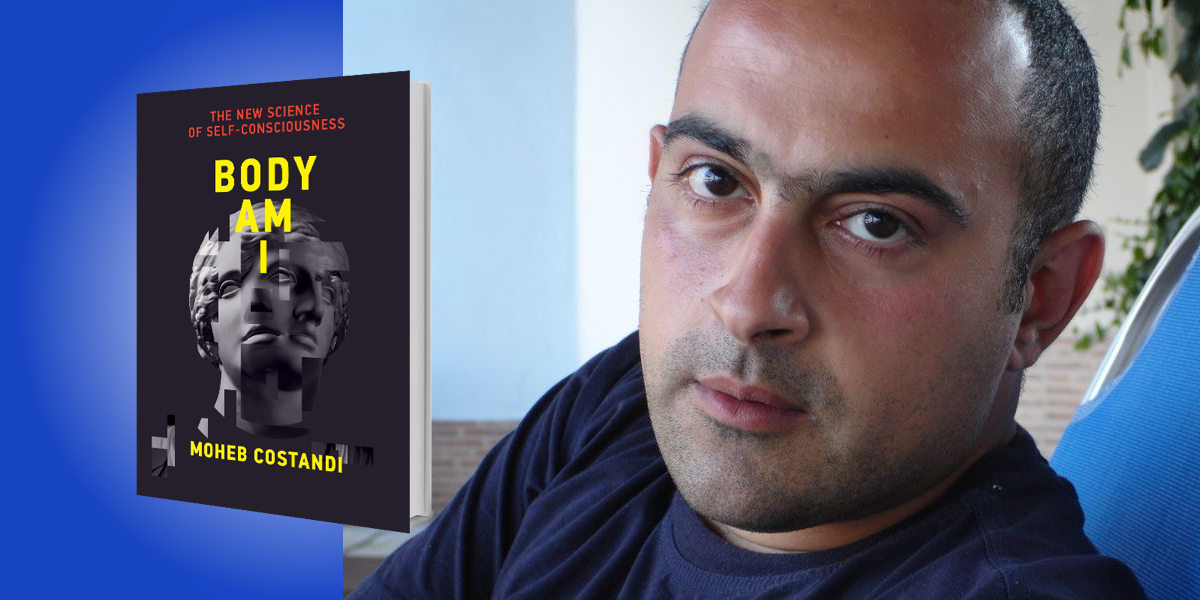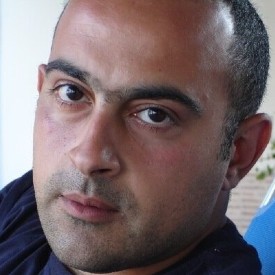Moheb Costandi, trained as a neuroscientist, is a science writer whose work has been featured in publications such as Nature, Scientific American, and New Scientist.
Below, Moheb shares 5 key insights from his new book, Body Am I: The New Science of Self-Consciousness. Listen to the audio version—read by Moheb himself—in the Next Big Idea App.

1. The mind, brain, and body are inextricably linked.
The idea that the mind and brain are separate is usually attributed to the seventeenth century French mathematician and philosopher René Descartes, who was what philosophers now call a substance dualist. Descartes believed that the mind and body are made of different substances: the body of a physical substance, and the mind of some mysterious, non-physical material.
Today, most neuroscientists reject this idea. Modern brain research suggests that the mind is made of matter and emerges from brain activity. Even so, most still study the brain in isolation, without taking the body into consideration.
In the early 1990s, researchers began using brain scanning methods to explore the neural correlates of consciousness. Typically, this involved scanning brains as people viewed visual stimuli that drifted in and out of conscious awareness and recording the brain activity associated with these processes. This approach told us about the brain mechanisms supporting conscious awareness of the outside world, but it ignored a large part of the problem of consciousness.
Being conscious does not just mean being aware of the outside world. It also means being aware of oneself and one’s relationship to one’s surroundings. The way we perceive our bodies plays a central role in self-awareness. The body also exerts subtle but significant influences on how we think and what we feel.
The brain exists as part of a dynamic, complex system that includes the body and the environment, and can only be understood in terms of how it interacts with these other components. This also means that the distinction between physical and mental health is false. Psychiatric conditions such as anorexia and depression do involve the brain, but they also involve a wide range of bodily symptoms. We will only understand such conditions, and treat them more effectively, by taking brain-body interactions into account.
2. Body maps.
The brain contains multiple maps and models of the body, and these maps and models are crucial for how we perceive and use our bodies.
Much of what we know about the brain’s body maps comes from the work of the Canadian neurosurgeon Wilder Penfield. Penfield co-founded the Montreal Neurological Institute in the 1920s and pioneered a technique for operating on conscious patients. He operated mostly on patients with drug-resistant epilepsy. In some of these patients, the seizures become so frequent and severe that surgery to remove the tissue causing them was performed as a last resort. But the brain is a complex organ that controls speech, movement, and many other vital functions. Penfield’s technique enabled him to identify the abnormal tissue and surgically remove it while leaving surrounding tissues that perform vital functions.
“These maps represent the body disproportionately, with the most sensitive body parts (the face and hands) taking up most of the space.”
To do so, he asked his patients to speak (for example, to count) as he applied small electrical currents to their brain. If this interrupted their speech, he knew to avoid that part of the brain during the surgery. In this way, Penfield could remove the locus of the seizures while leaving vital functions intact.
Penfield operated on hundreds of patients and one of his most important discoveries was that the areas of the brain that process touch and control movement contain highly ordered maps of the body, with adjacent body parts located on adjacent regions of the map. But these maps represent the body disproportionately, with the most sensitive body parts (the face and hands) taking up most of the space, and the rest of the body crammed into the rest. This discovery is immortalized in the famous homunculus (meaning little man) often depicted as a 3D model of the body with a giant head and hands and tiny body. Penfield’s technique is used to this day.
3. Multisensory integration.
The brain combines touch information with visual information, information about limb position from the muscles and tendons, and sensory signals from the internal bodily organs in a process called multisensory integration. It uses the information to generate models of the body.
These models are highly dynamic and can be easily manipulated, as demonstrated in a simple lab procedure called the rubber hand illusion. Here, one sits at a table with one hand on a table and the other out of sight, looking at a fake rubber hand put in its place. When their hidden hand and the fake rubber hand are synchronously stroked with a paint brush, they begin to feel as if the touch sensations are coming from the fake hand. This simple manipulation creates a discrepancy between what is seen and what is felt, and this is enough to make the person think the fake rubber hand is a part of their body.
The rubber hand illusion demonstrates the importance of multisensory integration for perception of the body and self. Manipulating these processes may be clinically useful.
“The sounds our bodies make play a role in how we perceive our bodies.”
We know that the brain also integrates auditory information into its body models. That is to say, the sounds our bodies make play a role in how we perceive our bodies, and this knowledge is already helping in the development of novel treatments for obesity and eating disorders.
One group of researchers has developed “Magic Shoes” that send auditory feedback about a person’s footfalls via headphones. They have found that manipulating the sounds of footfalls can alter the way a person perceives their body, which in turn can alter behavior.
This and other discoveries are paving the way for a whole host of new body-based treatments, all of which exploit the principles of multisensory integration.
4. Body maps are malleable.
The maps are highly dynamic and malleable, and can be altered by everyday experiences, injury, and a wide variety of neuropsychiatric conditions. When they change, our perception of our selves changes with them.
For example, in skilled violinists, the region of the body map representing the string fingers are enlarged and the extent of this enlargement is directly related to the amount of experience the individual has, with more experienced musicians exhibiting more enlargement. As a result, violinists are far more dextrous with their string fingers, and their string fingers are also far more sensitive than those of non-violinists.
Amputees almost always experience phantom limb sensations, the vivid feeling that the missing limb is still attached to their body. One explanation for this is because the brain’s body map still contains an imprint of the missing limb, and although that region of the map has been deprived of sensory inputs, it begins to process touch information from adjacent parts of the body. As the body map changes, so does the amputee’s perception of their phantom limb.
Phantom sensations can be very painful, but a simple method called mirror box therapy can alleviate phantom pain. This involves getting the amputee to place their remaining limb into a cardboard box with a mirror inside it and two sides cut away. The mirror reflects the remaining limb, giving the amputee a visual illusion of the missing limb. It’s not exactly clear why this is effective. It may be because phantom pain is partly caused by the absence of visual inputs from the missing limb.
“The maps are highly dynamic and malleable, and can be altered by everyday experiences, injury, and a wide variety of neuropsychiatric conditions.”
Most of us could think of few things worse than having a limb amputated, but people with a rare condition called Body Integrity Dysphoria want nothing more. From an early age, these individuals have the strange feeling that they should have been born without the limb and later on this develops into a burning desire to have it removed. This condition was initially regarded as a fetish, but there is now evidence that it has a neurological basis and may occur because the unwanted limb was not incorporated into the brain’s body maps when the maps were being drawn in early childhood.
5. Bodily awareness is the basis of self-consciousness.
Bodily awareness is critical for self-consciousness, and self-consciousness cannot exist without the body. This leads to surprising conclusions about what possesses consciousness.
In 2018, Silicon Valley entrepreneur Sam Altman paid a startup called Nectom $10,000 to preserve his brain after he dies, in order to upload his memories and consciousness to the cloud. This is based on transhumanists’ claim that when the technology becomes available, we will be able to upload our brain architecture to a supercomputer, and that this upload will then become conscious, allowing us to gain immortality. This idea was recently popularized in the Amazon sci-fi comedy series Upload.
At the moment, there isn’t a supercomputer powerful enough to store all the data from a single human brain. This will, however, be possible at some point in the future. But if the body is crucial for self-consciousness, then it follows that a mind uploaded to a supercomputer could never gain consciousness because it will be nothing more than a disembodied, virtual brain.
In recent years, neuroscientists have been growing cerebral organoids, or mini brains, in the lab. Some bioethicists argue that this may be unethical because the mini brains may eventually become complex enough to perceive pain or gain consciousness. By the same token, this is unlikely, because mini brains are nothing more than clumps of cells in a Petri dish. No matter how complex they become, they lack a body, and so cannot gain self-awareness.
On the other hand, if bodily awareness is crucial for self-consciousness, then we may conclude that consciousness is not restricted to humans and other so-called “higher” animals, but rather is widespread throughout the animal kingdom. Crustaceans and even insects exhibit signs of bodily awareness, and so possess at least basic consciousness. And researchers in the U.S. have developed a robot that builds its own updatable body model and can adapt its movements when one of its limbs are removed. Is this robot conscious, too?
To listen to the audio version read by author Moheb Costandi, download the Next Big Idea App today:































